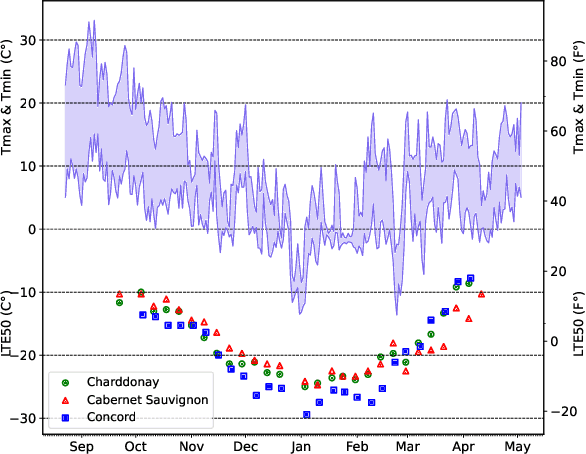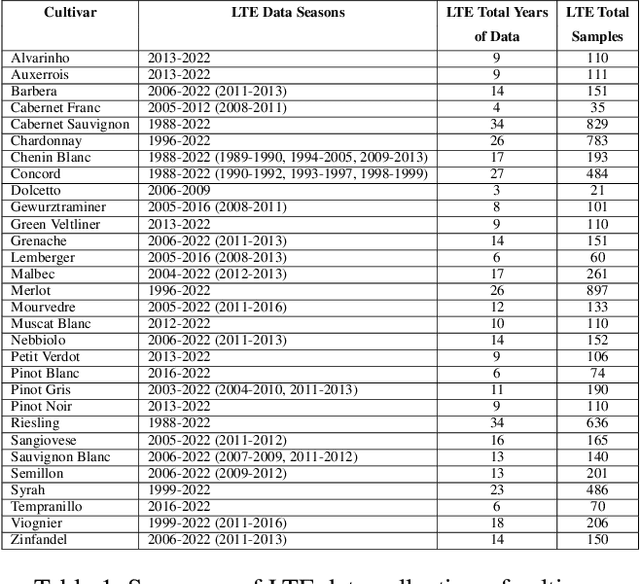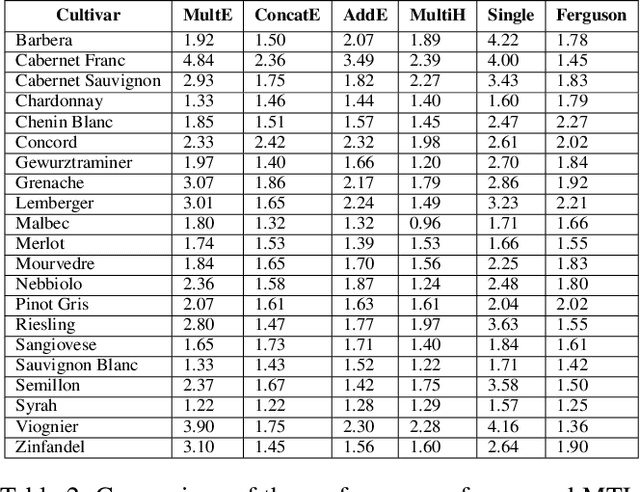Paola Pesantez-Cabrera
Transfer Learning via Auxiliary Labels with Application to Cold-Hardiness Prediction
Apr 17, 2025Abstract:Cold temperatures can cause significant frost damage to fruit crops depending on their resilience, or cold hardiness, which changes throughout the dormancy season. This has led to the development of predictive cold-hardiness models, which help farmers decide when to deploy expensive frost-mitigation measures. Unfortunately, cold-hardiness data for model training is only available for some fruit cultivars due to the need for specialized equipment and expertise. Rather, farmers often do have years of phenological data (e.g. date of budbreak) that they regularly collect for their crops. In this work, we introduce a new transfer-learning framework, Transfer via Auxiliary Labels (TAL), that allows farmers to leverage the phenological data to produce more accurate cold-hardiness predictions, even when no cold-hardiness data is available for their specific crop. The framework assumes a set of source tasks (cultivars) where each has associated primary labels (cold hardiness) and auxiliary labels (phenology). However, the target task (new cultivar) is assumed to only have the auxiliary labels. The goal of TAL is to predict primary labels for the target task via transfer from the source tasks. Surprisingly, despite the vast literature on transfer learning, to our knowledge, the TAL formulation has not been previously addressed. Thus, we propose several new TAL approaches based on model selection and averaging that can leverage recent deep multi-task models for cold-hardiness prediction. Our results on real-world cold-hardiness and phenological data for multiple grape cultivars demonstrate that TAL can leverage the phenological data to improve cold-hardiness predictions in the absence of cold-hardiness data.
Multi-Task Learning for Budbreak Prediction
Jan 04, 2023Abstract:Grapevine budbreak is a key phenological stage of seasonal development, which serves as a signal for the onset of active growth. This is also when grape plants are most vulnerable to damage from freezing temperatures. Hence, it is important for winegrowers to anticipate the day of budbreak occurrence to protect their vineyards from late spring frost events. This work investigates deep learning for budbreak prediction using data collected for multiple grape cultivars. While some cultivars have over 30 seasons of data others have as little as 4 seasons, which can adversely impact prediction accuracy. To address this issue, we investigate multi-task learning, which combines data across all cultivars to make predictions for individual cultivars. Our main result shows that several variants of multi-task learning are all able to significantly improve prediction accuracy compared to learning for each cultivar independently.
Grape Cold Hardiness Prediction via Multi-Task Learning
Sep 23, 2022



Abstract:Cold temperatures during fall and spring have the potential to cause frost damage to grapevines and other fruit plants, which can significantly decrease harvest yields. To help prevent these losses, farmers deploy expensive frost mitigation measures, such as, sprinklers, heaters, and wind machines, when they judge that damage may occur. This judgment, however, is challenging because the cold hardiness of plants changes throughout the dormancy period and it is difficult to directly measure. This has led scientists to develop cold hardiness prediction models that can be tuned to different grape cultivars based on laborious field measurement data. In this paper, we study whether deep-learning models can improve cold hardiness prediction for grapes based on data that has been collected over a 30-year time period. A key challenge is that the amount of data per cultivar is highly variable, with some cultivars having only a small amount. For this purpose, we investigate the use of multi-task learning to leverage data across cultivars in order to improve prediction performance for individual cultivars. We evaluate a number of multi-task learning approaches and show that the highest performing approach is able to significantly improve over learning for single cultivars and outperforms the current state-of-the-art scientific model for most cultivars.
 Add to Chrome
Add to Chrome Add to Firefox
Add to Firefox Add to Edge
Add to Edge